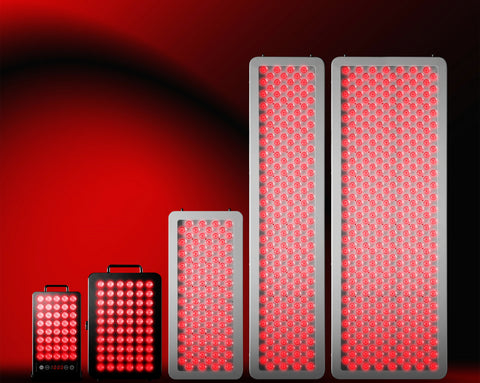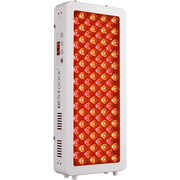The initial discovery of low level light therapy (LLLT) came after the findings of potential benefits from ablative laser treatments, such as reducing pain, improving wound healing, and alleviating inflammation and swelling. It once was the center of the debate in the choice of light sources for low level red light therapy, the choice between laser light therapy and LED red light therapy. However, with the technology evolving, low level LED light therapy has become widely used in LLLT devices.
In this blog, we will discuss the difference between laser light therapy and LED light therapy, what you can expect from them, and whether they can be suitable replacement therapies for laser devices. Are you ready to learn more about medical LED light therapy? Let's keep reading!

Laser vs. LED - What is low level light therapy?
A laser device is designed to generate light via an optical amplification process based on the stimulated emission of photons. The characteristic of laser light is a high degree of spatial and temporal coherence. Spatial coherence is often expressed as a small diffraction-limited beam; to concentrate the power of light, lasers can be released into a beam with very low divergence at a large distance. Temporal (or longitudinal) coherence refers to a polarized wave at a single frequency whose phase is linked over a reasonably long distance (the coherence length) along the beam. Typically, the irradiance of laser sources is postulated to have a Gaussian shape (that of a normal distribution), where there is a peak irradiance and the irradiance drops as one moves away from the center of the beam. This might be useful in instances when electricity is distributed unevenly because the irradiance in the tail of the Gaussian profile grows as power increases, as does the distance of the critical threshold from the center of the beam. The spot size for this sort of profile is often referred to as the 1/e2 radius of the beam or the beam's diameter, i.e., the irradiation is lower by a factor of 1/e2 relative to the peak irradiance, and about 85% of the power of the laser beam is present within the 1/e2 diameter.

The HeNe laser, which generates light with a wavelength of 632.8 nm, was utilized in most early studies in LLLT, whereas up-to-date semiconductor diode lasers such as gallium arsenide (GaAs) lasers are more prevalent. It was once thought that laser light coherence was critical to achieving the therapeutic benefits of LLLT, but this view has lately been violated by the use of LEDs, which generate non-coherent light across a broader range of wavelengths than lasers. It is yet to be confirmed whether there is a true difference between laser and red LED light therapy because a lot of clinical red light therapy demonstrates LED infrared red light therapy benefits.
Organic light emitting diodes (OLEDs) will be the next advancement in LLLT devices in the future. The emissive electroluminescent layer in these LEDs is a film of organic compounds that release light while being responsive to an electric current. They work similarly to standard semiconductor materials in that electrons and holes recombine to generate an exciton. With the radical changes in LED manufacturing nowadays, LED sources can also emit light with a high concentration of wavelengths and a high irradiance output.
Both the red and infrared LED light therapy and red light laser therapy use the wavelengths for LLLT which fall into an optical window at red and NIR light therapy (600 – 1079 nm) because what determines the choice of wavelengths are chromophores and human tissue structure. This range of wavelengths has the maximum penetration ability, as wavelengths in the range 600-700 nm are used to treat superficial tissue, and longer wavelengths in the range 780–950 nm are more apt for deep-seated tissue treatment due to the difference in penetration depth.

Wavelengths in the range 700-770 nm have been found to have limited biochemical activity.
According to contemporary quantum theory, ER is made up of photons, which are packages of energy that travel at the speed of light. The brightness of the light is correlated to the number of photons in this particle perspective of light, and the color of the light is correlated to the energy contained in each photon.
The comparable information of laser and LED red light therapy device comes from this study.
Can LEDs be used as a replacement for lasers in LLLT devices?
However, similar therapeutic effects of red light laser therapy have been identified in LED light therapy benefits, because what determines the effects of LLLT red light therapy are the fundamental mechanisms and tissue properties. When the light hits the biological structure, part of the light is absorbed, part is reflected or scattered, and the last part is transmitted into the depth of the tissue.

Most of the light is eventually absorbed by the tissue, which leads to the energy states of molecules. According to quantum theory, the absorption of a photon takes place only when its energy corresponds to the energy gaps of different quantized states. This absorption phenomenon takes responsibility for the desired effects on human tissue, with the reciprocal relationship of the absorption coefficient and the penetration depth. The scattering factor is not isotropic, which is characterized by the anisotropy factor with an absolute value from 0 to 1. Though forward scattering has a predominant influence over the biological structure, this value can vary from 0.8 to 0.99.
Although the mode of laser irradiation may affect tissue absorption, the underlying biochemical mechanism of low level red light therapy is the same. That is why red LED therapy has proven effective in many clinical cases of red light phototherapy, and LED infrared red light therapy devices have been recognized by the FDA. The cellular mechanism of red and low level infrared light therapy is through the action of the mitochondria to increase ATP production, modulation of ROS, and the induction of transcription factors. The changes in the cellular redox state caused by the photon absorption of the chromophore cytochrome c oxidase (CCO) will trigger several transcription factors. These transcription factors then trigger further effects downstream, such as enhanced protein synthesis, increased cell proliferation and migration, modulated levels of several cytokines, growth factors, and inflammatory mediators, and increased tissue oxygenation.
Though there is a variation of responses for different cell types to different light sources, true medical-grade LED red light therapy devices can overcome the technological challenges and be versatile for a wide range of medical conditions.
This study demonstrated the biological effects of low level LED light therapy for wound healing, similar to that of red light cold laser therapy, with even the similarity of irradiance parameters. This study determines the biological effects that support the use of LED on wound healing, including red light therapy for inflammation, such as the decrease of inflammatory cells, increased fibroblast proliferation, stimulation of angiogenesis, granulation tissue formation, and LED light for collagen production.
These effects were also reported in a varied range of medical applications. Both laser and red LED light therapy benefits a wide range of medical conditions which can be verified through numerous clinical studies in recent years.
Bestqool is everything you need

Bestqool packs everything you need for providing the best red light therapy at home. With years of engagement in LED red and near infrared light therapy field, Bestqool is able to deliver best LED red light therapy for home use, with a high concentration of wavelengths and the availability of high irradiance levels as direct output, to meet the needs of true medical red light therapy devices.
As true FDA-cleared red light therapy devices, Bestqool devices guarantee the safety and effectiveness of light therapy processes. All Bestqool devices are registered as FDA Class Ⅱ medical devices and abide by the highest safety standards in this industry. From handheld LED light therapy devices to full-body red light therapy devices, Bestqool provides versatility of choices for different medical conditions. The LED light therapy masks are the best option for your best face red light therapy, by which you can switch different modes of LED light, different combinations of wavelengths, and different levels of skin sensitivity. This mask is specialized in acne treatment and skin rejuvenation and won a series of positive feedback from our clients. Red light therapy belts are designed especially for medical treatments for arthritis, back pain, and so forth in musculoskeletal disorders. Though it is equipped with the flexibility of belt design and limitation of direct touching irradiance, it still assumes a high level of direct irradiance output under the control of heat tolerance to meet the medical-grade treatment. Bestqool red light therapy panel can be the best option for whoever gets started with red and infrared light therapy. With superior optics and the most versatile design, it is perfect for those seeking a solution for systematic improvement.
All Bestqool devices are also combined with a three-year warranty, which is the longest standard in this market, for the mission of Bestqool is to bring the best at home red light therapy experience to our clients. And you can trust us!













 Small
Small

 Moderate
Moderate

 Moderate
Moderate

 Moderate
Moderate

 Full
Full



